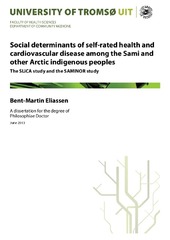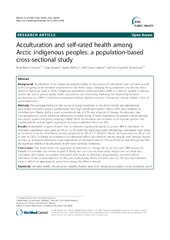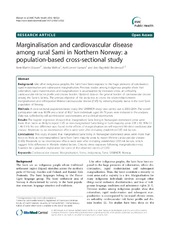| dc.contributor.advisor | Broderstad, Ann Ragnhild | |
| dc.contributor.author | Eliassen, Bent-Martin | |
| dc.date.accessioned | 2013-11-14T12:20:52Z | |
| dc.date.available | 2013-11-14T12:20:52Z | |
| dc.date.issued | 2013-11-07 | |
| dc.description.abstract | The post-World War II years in the Arctic were characterised by an intensification of sociocultural change. Previous studies among indigenous peoples show that colonialism, rapid modernisation and subsequent marginalisation and sociocultural change are accompanied by overall ill health and a negative cardiovascular risk profile and disease burden. Paper I showed that aggregate acculturation was a strong risk factor for poorer SRH among the Greenlandic Inuit and female Iñupiat of Alaska.Paper II (n=4027) showed that marginalised Sami living in Norwegian dominated areas were more than twice as likely (OR 2.10) as non-marginalised Sami from Sami majority areas to report lifetime CVD. Moderate to no intermediate effects were seen after including established CVD risk factors, which suggest little difference in lifestyle related factors. Chronic stress exposure following marginalisation may however be a plausible explanation for some of the observed excess of CVD.
Paper III (n=15,206) showed an excess of angina pectoris symptoms (APS), self-reported angina, and a combination of these in Sami women and men relative to non-Sami women and men. Total cholesterol, metabolic syndrome, smoking, family history of cardiovascular disease, and moderate alcohol consumption explained little or none of the ethnic variation in APS. The excess burden of APS was in Sami women principally due to known cases of angina pectoris. In men however the discrepancy in prevalent angina symptoms may be due to an excess burden of undiagnosed disease among the Sami. These results may indicate under-utilisation of health care services among Sami men which suggest that social determinants play a role in the distribution of APS in this population. The results in Paper II also suggest that marginalisation and subsequent chronic stress may be an additional driving force influencing the population burden of lifetime cardiovascular disease among the Sami.. The results found in Paper I also support further exploration of the social determinants of ill health in other indigenous populations. | en |
| dc.description.doctoraltype | ph.d. | en |
| dc.description.popularabstract | Avhandlinga er basert på data fra befolkningsundersøkelsene SLiCA og SAMINOR. Spørreskjemadata fra SLiCA viser en sammenheng mellom indikatorer på sosiokulturell forandring og dårligere selvoppfattet helse blant inuitter på Grønland og blant inuittkvinner i Alaska. Stress og negative livsstilsendringer kan forklare dette.
I avhandlingens andre artikkel ble det brukt klinisk data og spørreskjemadata fra SAMINOR til å belyse forekomsten av hjerte- og karsykdom blant 4027 samer i Nord-Norge. Vi fant en sammenheng mellom det å føle seg marginalisert og forhøyet forekomst av hjerte- og karsykdom i samiske minoritetsområder. Ingen slik sammenheng ble funnet i de samiske majoritetsområdene (Kautokeino, Karasjok, Nesseby, Tana og Porsanger). Videre fant en at forekomsten av hjerte- og karsykdommer var over dobbelt så høy blant marginaliserte samer i minoritetsområdene sammenliknet med samer i majoritetskommunene.
Avhandlingas tredje artikkel brukte SAMINOR-data fra 15,206 personer. Denne studien viste at forekomsten av hjertekrampe var høyere blant samer enn ikke-samer. Uansett hvordan hjertekrampe var målt fant en høyere forekomster blant samer. Mindre bruk av helsetjenester og stress kan være bidragende årsaker.
Avhandlingen har belyst noen sosiale forhold som kan være viktige forklaringsfaktorer på ulik folkehelse i samiske områder. | en |
| dc.description.sponsorship | Universitetsstipend | en |
| dc.description | Paper 3 of this thesis is not available in Munin: <br/>3. Eliassen BM, Graff-Iversen S, Melhus M, Hansen KL, Løchen ML and Broderstad AR.: 'Ethnic difference in the prevalence of angina pectoris in Sami and non-Sami populations: The SAMINOR study' (manuscript) | en |
| dc.identifier.uri | https://hdl.handle.net/10037/5507 | |
| dc.identifier.urn | URN:NBN:no-uit_munin_5209 | |
| dc.language.iso | eng | en |
| dc.publisher | University of Tromsø | en |
| dc.publisher | Universitetet i Tromsø | en |
| dc.relation.ispartofseries | ISM skriftserie, nr 142 | |
| dc.rights.accessRights | openAccess | |
| dc.rights.holder | Copyright 2013 The Author(s) | |
| dc.rights.uri | https://creativecommons.org/licenses/by-nc-sa/3.0 | en_US |
| dc.rights | Attribution-NonCommercial-ShareAlike 3.0 Unported (CC BY-NC-SA 3.0) | en_US |
| dc.subject | VDP::Medisinske Fag: 700::Helsefag: 800::Samfunnsmedisin, sosialmedisin: 801 | en |
| dc.subject | VDP::Medical disciplines: 700::Health sciences: 800::Community medicine, Social medicine: 801 | en |
| dc.subject | VDP::Medisinske Fag: 700::Helsefag: 800::Epidemiologi medisinsk og odontologisk statistikk: 803 | en |
| dc.subject | VDP::Medical disciplines: 700::Health sciences: 800::Epidemiology medical and dental statistics: 803 | en |
| dc.title | Social determinants of self-rated health and cardiovascular disease among the Sami and other Arctic indigenous peoples. The SLiCA study and the SAMINOR study | en |
| dc.type | Doctoral thesis | en |
| dc.type | Doktorgradsavhandling | en |


 English
English norsk
norsk


